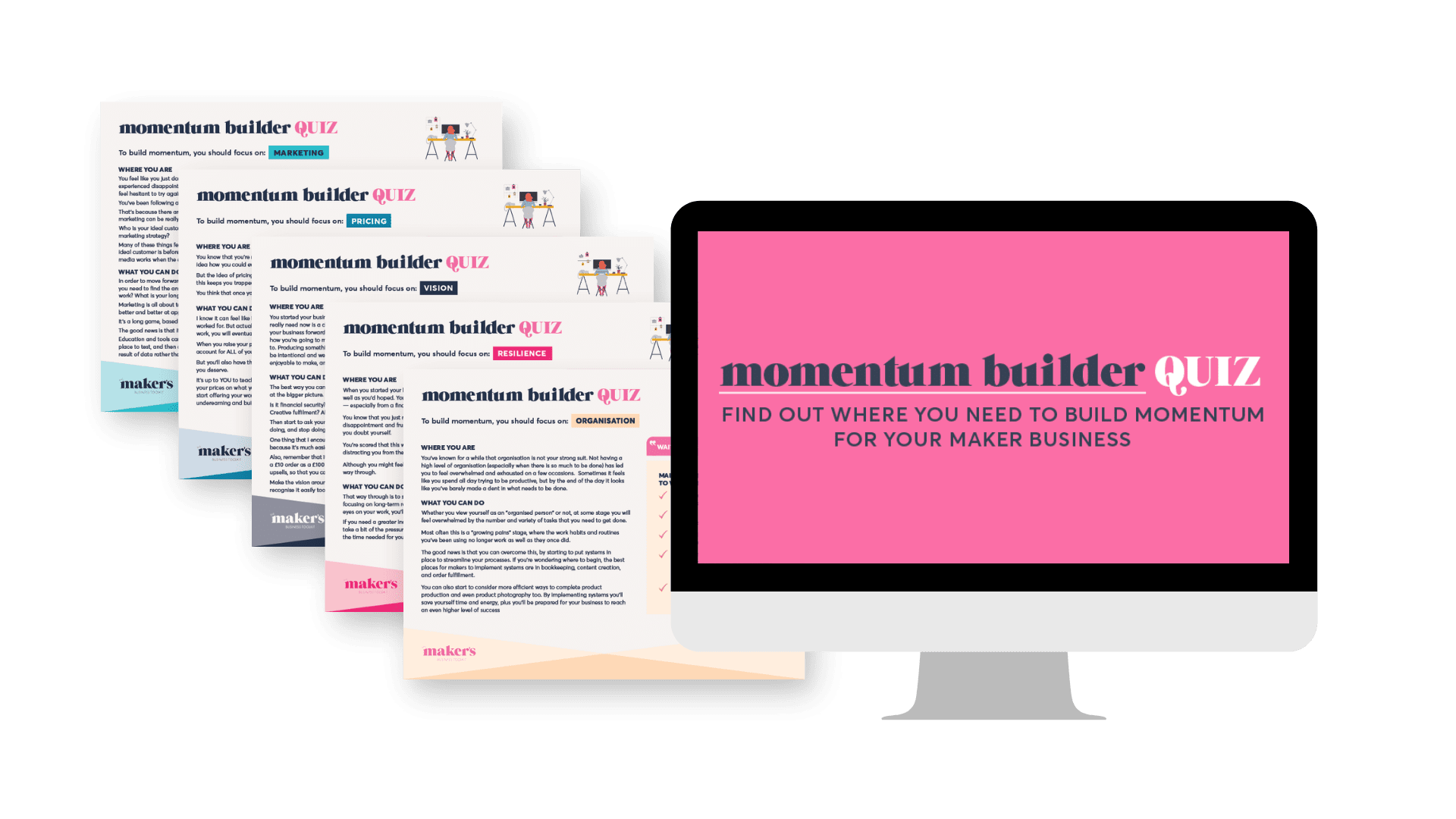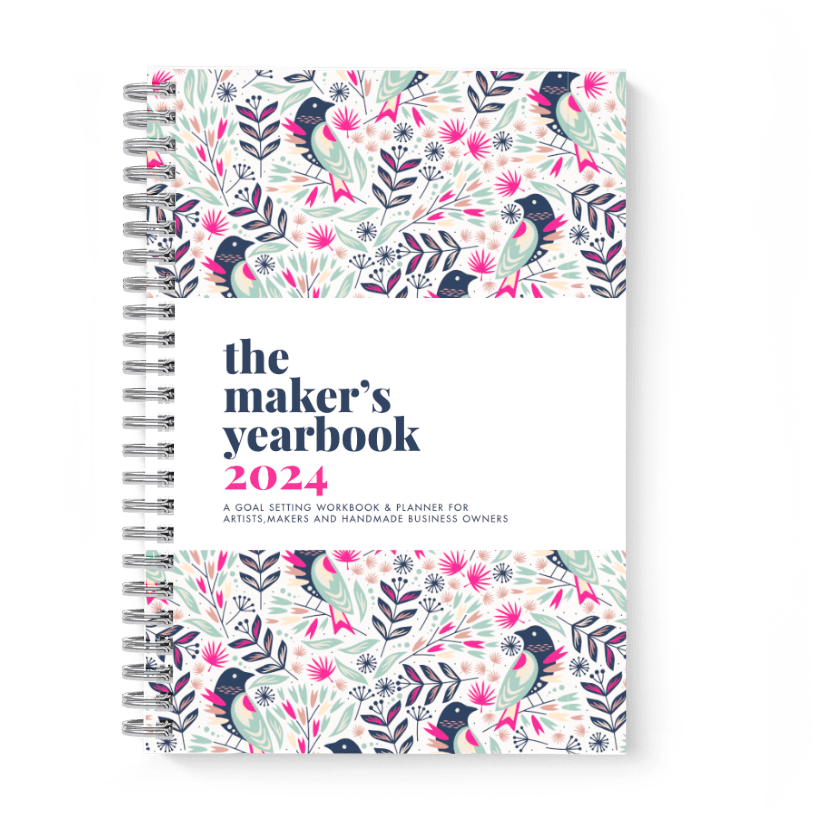“There has never been a better time to set up your own online store, so that you can sell to your customers online.
Why?
Because the technology is getting easier and more accessible all the time. Because craft fairs have become tougher and tougher over the past few years. Because brick and mortar retailers are struggling. And, most importantly of all, because your customers expect it.
It is really important to have diversified streams of income. This means that you don’t get all of your income from one source. We have all heard the horror stories of makers who built up thriving businesses on Etsy or Not on the High Street, only to lose it all when these companies change their policies or the direction of their business.
Your own online store belongs to you. No one can shut you down because they don’t like the way you make your products or because your products no longer fit their aesthetic.
Your livelihood is not at the mercy of other people.
Shops close down, fairs lose momentum, but your own website is your open-all-hours way to keep your work generating income for you, no matter what.
This is not to say that selling online is easy. There is a learning curve and we all know that you cannot simply open your online store and expect the sales to come rolling in. It requires work and constant marketing and sometimes you have to pay to get people to find your online store, just like you have to pay a fair organiser to get in front of customers.
But an online store, marketed well expands your audience by an enormous amount. You can sell outside your geographic area, maybe even outside your country. This is so important for artists who make work with a very niche audience. There might be tens of thousands of people in the world who love what you do, but only a couple of hundred in your local area.
So what do you need to do to be successful selling online?
1. Market your store every single day
We all know someone who built an online store, spent ages uploading photos and product descriptions, tweaking delivery policies and then launched it with a big fanfare to …….crickets. We might have even done it ourselves (*putting my hand up here).
The big mistake we made is that, once we had built our store, we thought the work was over when, in fact, it was just beginning.
Getting your store set up is by far the easiest part. The hard part is getting people to visit.
Imagine setting up shop in a small town and then just waiting for people to show up. You wouldn’t do it. You’d at least do something to try and get them there. Maybe you’d host a grand opening event with some special offers. Maybe you’d advertise. Maybe you’d use social media to tell as many people as you could. Maybe you’d write to or email your existing customers telling them about your new store. It’s the same online.
You’ve built your site? Great. Now the work really begins. And it goes on each day so you need to find a way to work it into your daily schedule.
2. Have great photos
When shopping online, photographs are the single best piece of information that a customer has in order to decide if your lovely thing is for them or not. The photo HAS to do it justice, because that’s all they’ve got. Out of focus, dark, distracting backgrounds, shot on a towel in your living room just will not cut it.
There is very little point busting a gut trying to get people to your online store if what they see when they get there isn’t a good representation of your product.
You can do your own product photography, you absolutely can, but you should consider if this an area where it is worth spending money.
PRODUCT PHOTOGRAPHS ARE SO MUCH MORE IMPORTANT THAN HAVING A PROFESSIONALLY DESIGNED WEBSITE AND MANY OF YOUR MARKETING EFFORTS WON’T WORK WELL WITHOUT THEM.
It takes time and effort to learn how to do it well, so if you are going the DIY route, you will need to dedicate some time to this and probably take a photography course. Just make sure you take a course specifically for product photography and taught by someone who is a product photography specialist.
I am a professional photographer and I can’t do product photography well. It’s hard. Get some help.
3. Have great photos
Yes, it’s so important I’m going to say it twice!
And your photos can’t just SHOW the item, they’ve got to SELL the item too. They can’t just show the viewer the item and hope they’ll want to buy it. They need to sell the lifestyle that goes with it. Do I want to be like this person or decorate my house like this? Do I wish I lived by the sea or in a little country cottage? Will your jewellery or artwork make me feel like I have a little part of that in my own life?
White box shots don’t sell products to end customers. They are for wholesale and the press. You need to sell a lifestyle choice when you are selling directly to your customers.
4. Have a focused range of products
Online you have a very limited window of opportunity to grab someone’s attention and make them understand you and your work.
Studies suggest that the amount of time someone spends on your website before deciding if they want to stick around or not is between 15 and 59 seconds. If they don’t understand who you are and what you do – they won’t bother to look further, they will simply click away.
A focused range helps people to put you into a box. Not ideal I know, but like it or not, people want to put you into a category – Scandi style lampshades, seaglass jewellery, black and white flower photography.
Make it easy for them to figure out what you do and explain it to another person.
That doesn’t mean you need to get rid of your additional product lines, but maybe keep them off the front page and use that for really promoting your key lines.
5. Build Trust
Trust is so important online. Think about it. If you go into a large department store and buy an item of clothing, you don’t think twice about whether it will fall apart. You know that, if it does, you can take it back and get a replacement or a refund.
You know that, the shop will be there tomorrow. You know that the shop will accept the item back. You know that the shop isn’t a scammer trying to steal your credit card details. There is an inherent level of trust. You don’t have that when selling online. You have to start from a much lower base of trust.
Things like showing your face on your About Page, having a professional looking store that is formatted correctly, having your address on your website (yes, I know you don’t want to but you really don’t have a choice) and having nice customer friendly return policies.The higher your prices, the higher the level of trust you need to establish in order to convert those prospects into sales.
6. Have customer friendly product descriptions
Your product descriptions should give your customer all of the essential information they need to make a purchase (materials used, sizes, basic care instruction) but they also need to make them imagine how it could fit into their lives and why they should want it.
Your product descriptions should not include artspeak (“dialogue” and “paradigm” are definite no-no words)
They should also not talk about techniques that your customers are unlikely to be familiar with, without explaining them.
You may think that you are sounding professional, but they feel stupid or confused and don’t hang around to buy anything.
7. Have clear navigation
Your online shop is not the place to be enigmatic. Just as your about page needs to have your photograph (and not one where you are holding something in front of your face), the rest of your website needs this clarity too.
Your customers want to be able to find your products. So, for your main navigation menu collect your products together in rational ways – necklaces, earrings, prints, stationery. These are all clear. “Natural Forms” is not. Use collections in your advertising and on your actual homepage, but keep the navigation menu as clear as possible.
It’s important to be clear for so many reasons, but SEO is a really big one. We’ll go into SEO for product sellers in another post but SEO helps you get found, both in search engines and on social media, so it’s a really good idea to start practicing being clear as soon as possible.
Equally, don’t call your blog “love letters” or “scribbles.” There is a time for personality and a time for clarity and this is the time for clarity. If you want to name your mailing list, that can work really well, (think The Insiders Club, or the Monthly Love Letter) but when people are first exploring your site you don’t want them to be confused.
8. Cut your losses short and let your winners run
This is a throwback to my old stockbroker days (did you know I was a stockbroker? Ah, it’s a story for another time).
The basic theory is that most people hang onto things that aren’t working for too long, in the hope that they will improve. But a much more effective strategy is to put all of your effort and attention into the things that are working and to find more of those.
For us a simple way to do this could be to discontinue your worst performing products once a year and try something new with the extra time, energy and money. It can be disheartening to try something and then have to get rid of it only a few months later but this is the only way that we grow and learn. You weren’t born knowing what would be your best sellers and neither was even the most successful online seller so be adaptable. Make changes where you need to and you will be happier, wealthier and more successful as a result.
9. Get a mailing list
Selling online is different than selling in person and it requires a different approach.
Attention spans online are short. Computers crash, browsers shut down, there’s a crash from the kitchen. the boss walks past.
There can be any number of reasons why people would get interrupted while browsing your site and you need a way to stay in contact with them.
Sending out a monthly store update with new products, special offers and news is like hosting your own mini craft fair online. Social media is good for keeping in front of customers too but nothing beats email marketing for effectiveness.
10. Get your postage right….and stop guessing!
Make sure that your postage costs are accurate. Again, this isn’t the sort of thing that should slow you down at the beginning.
In all likelihood you won’t be making that many sales at first so you have some time to experiment with different price levels for your postage and see what works best for you.
You can work out the weight and box size for your products and then check your postal service’s website to find out the costs.
Make sure you include the cost of the packaging as well as something for your time in packing the order and taking it to the post office.
If you’re using a courier service, look at companies like Interparcel and Parcel2Go who get discounted rates with major couriers (UK Only). Parcel services like Hermes or Collect+ are an option too.
Be especially careful with large overseas orders, especially if your product is very large. It is easy to lose a lot of money guessing (believe me, I know) so be sure to do your homework.
Overseas postage costs can look very expensive but don’t let that put you off offering your products to overseas buyers. Let them decide if the postage costs are too high.
There has never been a better time to start selling online.
Your customers are doing more and more of their shopping online. They are shopping on Facebook, on Instagram, on Pinterest. They might see you at a show and want to buy from you later.
Getting started can be tricky and intimidating but this is your livelihood and you’re losing sales every day you aren’t selling and marketing online. Keep testing and trying new things and you’ll soon find your feet.
Don’t have a website yet and not sure which platform to choose? Take a look at our guide here








